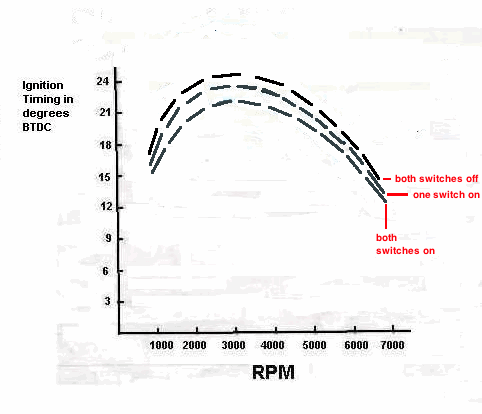|
There are two on-board switches on the circuit board. Switch 1 (SW1) is a dual switch that controls the whole ignition timing curve (to be more advanced or retarded/delayed) which has the most affect at mid RPM. Switch 2 (SW2) is a triple switch that controls the amount of retard curve to the timing after 3600 RPM without changing the low RPM timing. So it has the most affect at high RPM. Below you can see the graph for switch 1 and the resultant timing curves resulting from what the switch positions are.
DETERMINING BEST SETTINGS: You can test the settings for your bike to see what works best. Jetting, porting, compression*, and exhaust pipe all affect the needed timing. Test SW1 at idle and going up hills and test SW2 for top speed on a level road. Which ever settings allows the best power are the ones you should use. * high compression heads with squish bands (when the clearance to the piston is no more than .8mm) burn the mixture quicker and so needs retarded ignitionHOW TO UTILIZE THE SWITCHES: Just remove the boxes 4 screws (hidden under rubber feet) with a small Phillips screwdriver. Once the box lid is removed you can see the switches and easily change their lever positions using your fingernail or a small screwdriver. Switch 1 on positions are "up" and switch 2 on positions are "left" when the components board is positioned the same as in the drawing below. More resistance (in ohms selected by switch 1) causes more ignition advance (at mid RPM). More capacitance (in uf selected by switch 2) causes more top RPM ignition retard. More retard befits engines with a low peak RPM (ie: non-modified engines). Less retard befits engines with a high peak RPM (ie: modified engines).  |

